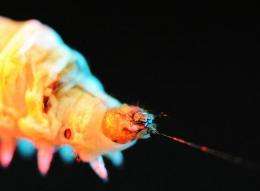Spider know-how could cut future energy costs

(�鶹��ԺOrg.com) -- Scientists at Oxford University and The University of Sheffield have demonstrated that natural silks are a thousand times more efficient than common plastics when it comes to forming fibres.
A report of the research is published this week in the journal Advanced Materials.
The finding comes from comparing silk from the Chinese silkworm (Bombyx mori) to molten high density polyethylene (HDPE) - a material from which the strongest synthetic fibres are made. The researchers used polarised light shining through a disk rotating over a plate to study the how fibres are formed as the two materials are spun.
HDPE forms filaments at over 125 C and in addition requires substantial energy input in the form of “shear force” applied to the material in its molten form. Silks, in contrast, in the same set-up forms filaments at ambient temperature and in addition requires only a tenth of the shear force. If the energetic costs of melting HDPE are included for comparison, silks become a thousand times more efficient.
The discovery of low-energy method for fibre formation has led the researchers to view silks as a new class of polymers they call 'aquamelts'.
‘When aquamelts are quickly stretched they lose water, which helps them “lock in” fibre formation like a ratchet,’ said Dr Chris Holland of the Oxford Silk Group, part of Oxford University’s Department of Zoology. ‘This doesn’t happen with your everyday plastics which need to be cooled to preserve the fibres, making them inefficient and harder to process.
‘Silk produced by spiders and silk moths demonstrates combinations of strength and toughness that still outperform their synthetic counterparts. Not only are silks superior to man-made fibres, they are produced at room temperature with just water as a by-product.’
Dr Oleksandr Mykhaylyk, of the University of Sheffield, said: ‘This is in stark contrast to oil-based high performance fibres that require high temperatures and create harmful waste. Whilst the high performance and sustainable credentials of silks are well known, the spider and silkworm can now add one more to the list, low energy costs.’
Dr Chris Holland said: 'Combining the best of polymer science with biology we were able to determine how much energy is required to form these two fibres. And it seems that we have discovered some fundamental differences between natural and synthetic materials. With hundreds of millions of years of R&D in fibre production it is not surprising that silkworms and spiders have found ways to conserve energy while still making superior fibres.'
However it is not just about saving energy or even money. Dr Oleksandr Mykhaylyk said: ‘The important point of this study are the intellectual advances and fundamental understanding that can be achieved when two normally separate disciplines interact as closely as we did.’
Professor Fritz Vollrath, who leads the Oxford Silk Group at Oxford University, said: ‘This project is about being inspired by Nature to discover and implement things that can help mankind to weather the upcoming storms on our quality of life. This new insight has significant implications for the design and processing of novel bio-inspired synthetic polymers as well as bio-polymer manufacture.’
Provided by Oxford University

















